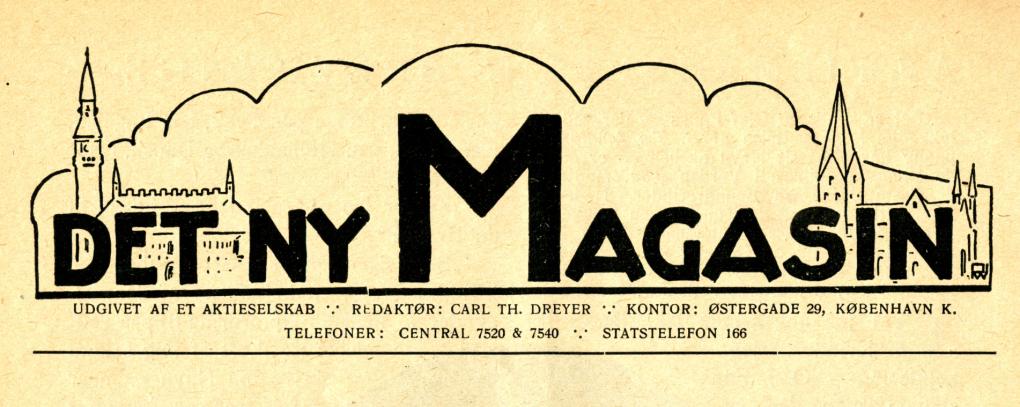
Det Ny Magasin was published by a limited company, registered at the address Østergade 29, Copenhagen -- the same building which is today occupied by The Body Shop on the pedestrian shopping street, Strøget. The first seven issues of the magazine were edited by Jens Ervø. Issue number eight is missing from the collection, but starting from issue nine, Dreyer is named as editor.
Serious film commentary, poems, short stories and miscellanea
In terms of content, the magazine features articles on Danish as well as foreign films and individuals, for example biographies of acting stars like Karina Bell and Olaf Fønss, an interview with film director Schnedler-Sørensen, and looooooong synopses of films such as Peter Ligeglad paa Eventyr (The Adventures of Peter Careless) and the British film A Gamble in Lives. The magazine also contains thematic pieces such as “Georg Brandes on film”, and on authors and composers. Various article series recur in each issue, one of which is “Film Artists when they were Children” (including sketches of the childhoods of actress Olga Svendsen, and actors Bertel Krause and Peter Jerndorff).
Det Ny Magasin also had a gossip column, reporting on the marriages of film stars. At least one short story (typically by Palle Rosenkrantz) can be found in each issue, plus a poem and a cartoon.
Casper Tybjerg, Associate Professor in Film History at the University of Copenhagen, is excited about the find. He explains:
“There are several fascinating things about Det Ny Magasin. It’s a publication aimed at ordinary but enthusiastic cinema-goers. There’s no snobbery in it against Hollywood or film stars; in fact, it’s noticeably populist in its attitude. It features several translated articles by foreign intellectuals discussing film, and this suggests that the editors kept abreast of international film publications.”
Who is ‘Bottom’?
The articles in Det Ny Magasin are signed by Rendegarn (The pseudonym 'Rendegarn' may allude to Shakepeare's 'Bottom' in A Midsummer Night's Dream, though this character takes different names in different productions of the play in Danish -- translator’s note), Eddy, Hannibal Nielsen (author of “Hannibal Nielsen’s Diary and Journal”, allegedly hailing from the fictitious town “Smørkøbing” or “Butterton”), the Old Wise Man, the Home Poet, and Crescendo. We can only guess who or what is hiding behind these pseudonyms. However, both Casper Tybjerg and Peter Schepelern, an Associate Professor in Film who researched Dreyer’s journalism back in the 1980s, think that Rendegarn or Bottom could be Dreyer’s pen-name:
"One of the issues edited by Dreyer (number fifteen) includes an interview, signed by Rendegarn, with the composer Carl Nielsen, who expresses his scepticism about film. After this interview an anonymous commentary has been inserted, which criticises Nielsen for his reactionary stance. It is tempting to believe that this was written by Dreyer. It’s funny that the cheeky arrogance that was so characteristic of the young Dreyer when he worked as a journalist for the newspaper Ekstra-Bladet is still in evidence here in 1923, when Dreyer is a little bit older, artistically ambitious, and at this point internationally known,” comments Casper Tybjerg.

Not completely new news
There is extensive extant research on Dreyer; very few stones have been left un-turned in regard to the director's life and work. However, Det Ny Magasinhas scarcely been mentioned by scholars, probably because very few people were previously aware of its existence. One exception is film scholar Peter Schepelern, who did discuss Det Ny Magasin, including the above-mentioned interview with Carl Nielsen, in his 1995 article ”Mellem lyst og plight" (Between desire and duty) in the journal MedieKultur (no. 23, pp. 10-11). The magazine is also currently listed in the catalogue of the Royal Library, though without any data other than its publisher, Martins Forlag. The catalogue entry does not indicate the number of issues published, nor their frequency.
Here at carlthdreyer.dk we will add Dreyer's engagement in Det Ny Magasin to his CV. New and established scholars of Dreyer are invited to get in touch with us if they would like to examine the magazine more closely.
Keeping it in the family
It is possible that Jens Ervø (1881-1947), who was a firebrand and entrepreneur on many fronts, came up with the idea for Det Ny Magasin -- and who else should he hire as co-editor but his brother-in-law, Carl Theodor (their respective wives, Ingeborg and Ebba, were sisters). 1923 saw a short lull in Dreyer’s directorial career: Der var engang (Once Upon a Time) premiered on 3rd October 1922, while shooting for his next film Michael would not begin until November 1923 in Berlin. Dreyer had a growing family to support: his wife Ebba, their daughter Gunni, and a new baby son, Erik. His job at Det Ny Magasin, then, put food on the table in the Dreyer household.
In the course of 1923, the magazine changed its name to Film Magasinet (The Film Magazine), and adopted the subtitle “Organ for Dansk Biografteater-Publikum” (Organ for the Danish Cinema Theatre Public), with its place of publication now Aarhus. The issue numbers at this point start again at number one, with Jens Ervø once again the sole editor.
Translation by Claire Thomson.
By Lisbeth Richter Larsen | 05. February
